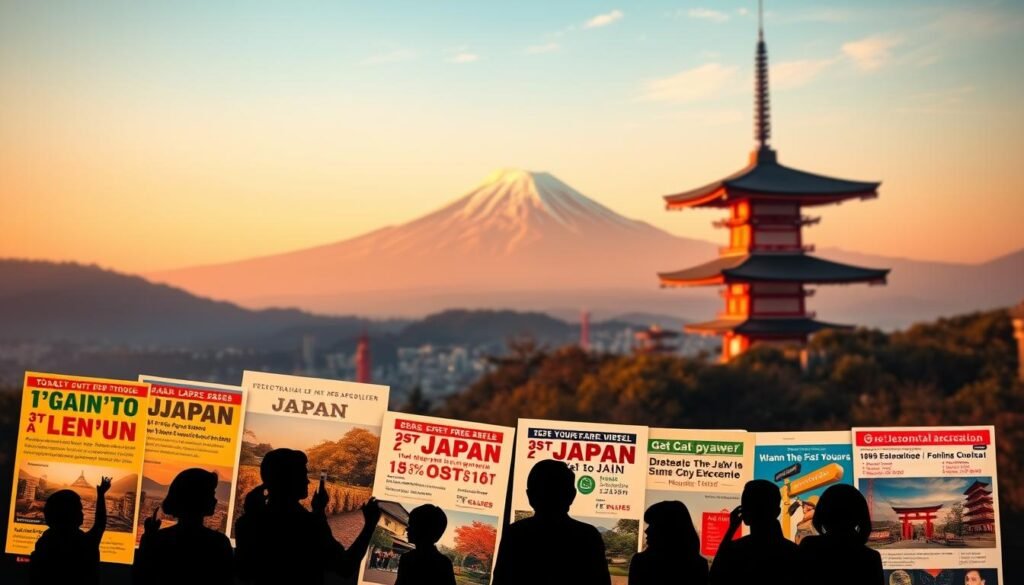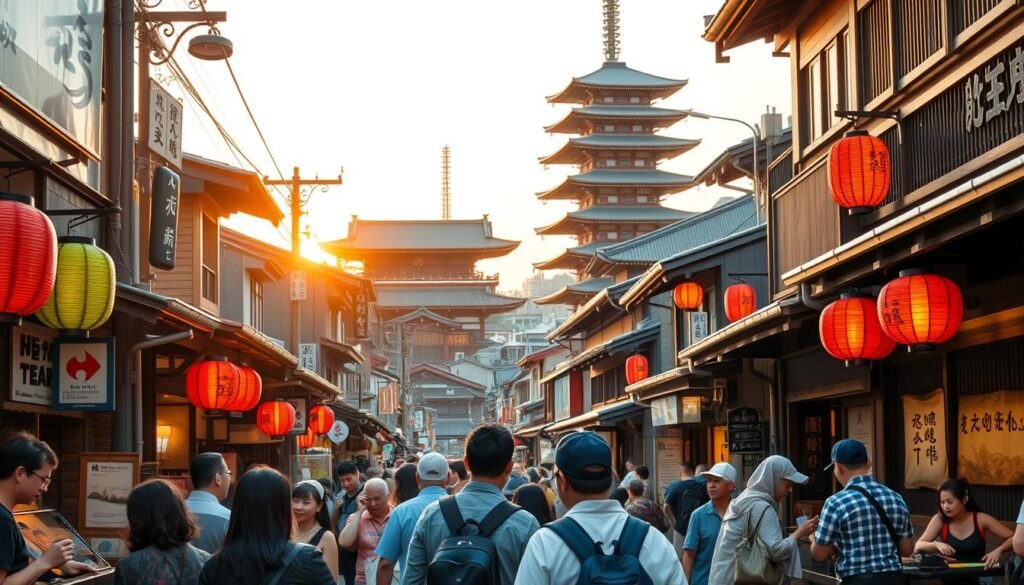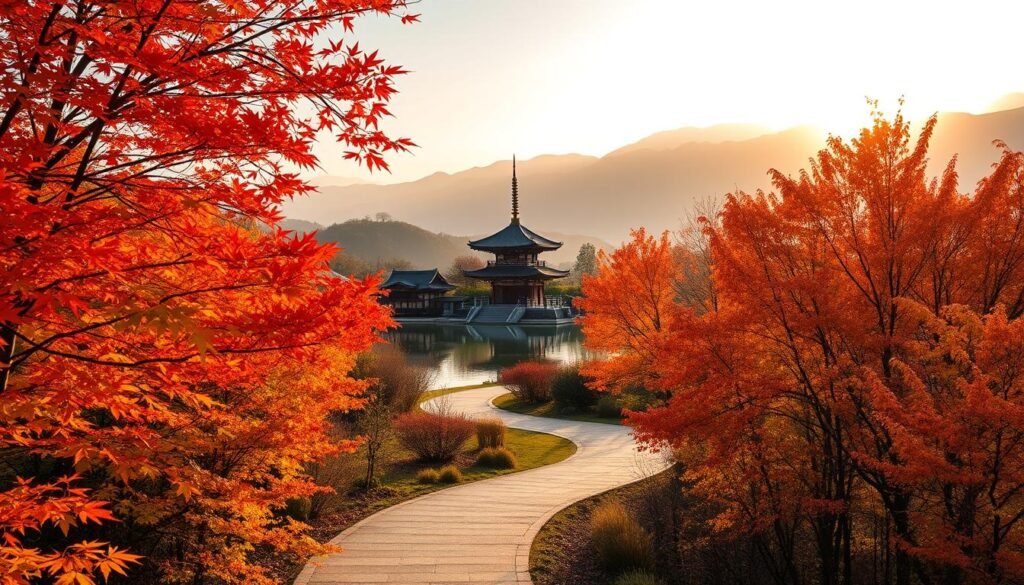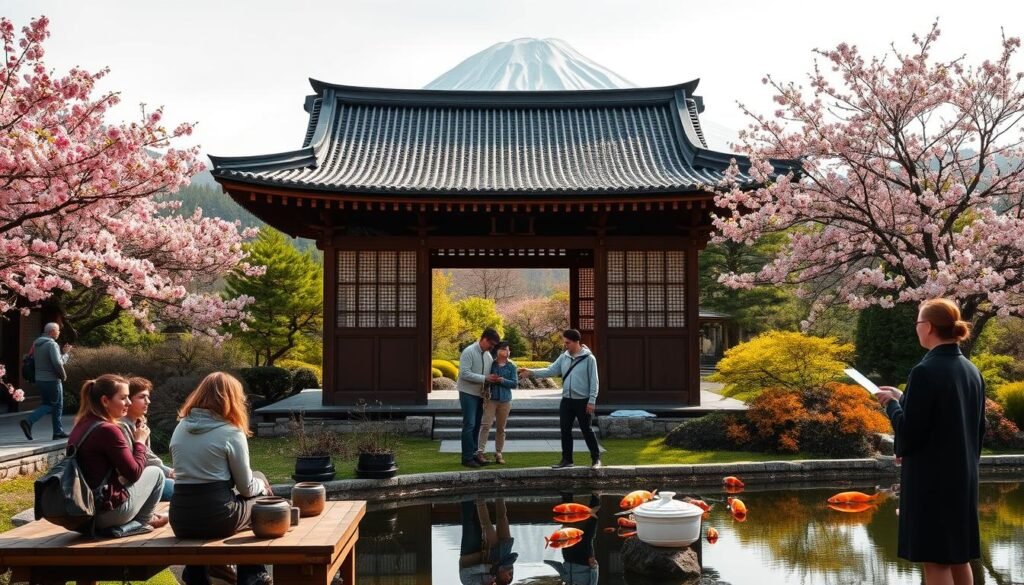I still remember the heart-pounding excitement of planning my first trip to this island nation. The neon glow of Tokyo’s skyline, the whisper of cherry blossoms in Kyoto these weren’t just postcard images, but dreams waiting to become real. Like many travelers, I almost drowned in endless options before discovering how strategic planning unlocks both savings and authentic experiences.
Over 40 years of expertise proves you don’t need unlimited funds to explore this destination. Companies like Japan Deluxe Tours have perfected the art of blending culture-rich itineraries with smart budgeting. Their guided adventures ranging from $1,698 to $6,331 transform overwhelming choices into seamless journeys through ancient temples and modern wonders alike.
What surprised me most? Seasonal specialties like anime-themed tours or sakura-viewing trips often include hidden discounts. By comparing group excursions with private custom options, I’ve helped friends save hundreds while gaining exclusive access to tea ceremonies and local markets. The secret lies in matching your travel style to the right package.
Key Takeaways
- Expert-planned tours available since 1981 cover must-see locations nationwide
- Multiple tour styles available, from cherry blossom journeys to pop culture adventures
- Prices start under $2,000 with luxury options exceeding $6,000
- Strategic booking can save hundreds without sacrificing key experiences
- Private tours offer personalized access to cultural landmarks
Introduction to Japan Travel Packages
There’s a special thrill in handing over the itinerary to experts who know every hidden gem. With 64 meticulously designed options available, I’ve learned these curated adventures remove the guesswork while preserving that delicious sense of discovery. Whether craving samurai history in Kyoto or neon lit nights in Osaka, bundled journeys combine flights, hotels, and guided experiences into one seamless plan.
What surprised me most? Even budget-friendly choices include English speaking guides and bullet train transfers between cities. A fellow traveler once told me, “Having someone handle the logistics let me focus on tasting every regional specialty from Hokkaido to Okinawa.” That’s the beauty of modern tours – they’re not rigid schedules, but springboards for authentic connections.
From quick 3-day getaways to immersive 24-day expeditions, operators craft journeys matching any calendar. Options departing Tokyo or Osaka simplify trip planning, while extended tours weave through multiple regions. Luxury seekers can indulge in private tea ceremonies with masters, proving tailored experiences aren’t just for high budgets.
Time strapped explorers appreciate how structured plans maximize each moment. Instead of deciphering subway maps, you’re learning origami from Kyoto artisans or bartering at Hakone’s open-air markets. It’s travel made thoughtful where every detail fuels your curiosity without draining energy on arrangements.
Unbeatable Deals & Limited Time Offers
My jaw dropped when I discovered how much I could save without skimping on quality. Last month, a friend saved $633 on a 14-night cultural immersion trip – enough to fund three extra days of sushi feasts. These aren’t fleeting promotions but year-round opportunities to upgrade your adventure.

Smart Bundles for Savvy Explorers
Combining flights with 4-star hotels cuts costs better than DIY bookings. One package I found includes 7 nights in Tokyo and Kyoto with bullet train transfers for less than $200/night. A travel buddy once whispered, “My bundled deal got me a ryokan upgrade I’d never splurge on alone.”
| Tour | Original | Discounted | Nights |
|---|---|---|---|
| Anime Adventure | $1,886 | $1,698 | 9 |
| Cultural Highlights | $3,331 | $2,998 | 14 |
| Grand Expedition | $6,331 | $5,698 | 21 |
Beyond the Price Tag
What excites me most are the hidden gems included. Recent deals offered:
- Morning meditation with Buddhist monks
- Behind-the-scenes sushi masterclasses
- VIP festival access during peak seasons
One operator even throws in free portable Wi-Fi – perfect for sharing those golden temple sunset pics. These extras transform good trips into legendary journeys without draining your wallet.
Planning My Getaway to Japan
Crafting the perfect itinerary felt like solving a puzzle where every piece unlocked new discoveries. I start by asking myself three questions: What cultural experiences excite me most? How many days can I dedicate? What’s my comfort zone for spending?
A seasoned traveler once told me, “Your priorities shape your journey more than any guidebook.” This wisdom helped me balance structured activities with free exploration days. Early planning also revealed surprising perks like discounted museum passes bundled with train tickets.
Essential Booking Tips
Securing spots during peak seasons requires strategy. I book key experiences 90 days out, leaving room for spontaneous ramen shop visits or unexpected festival finds. This table shows how timing affects availability and pricing:
| Booking Window | Availability | Average Savings |
|---|---|---|
| 0-30 days | Limited | 5% |
| 31-60 days | Moderate | 12% |
| 61-90 days | Wide | 22% |
Always verify entry requirements through official sources like Air Canada’s travel portal. A friend learned this the hard way when her visa paperwork delayed departure by two days.
Budgeting for My Trip
I divide my funds into four categories using the 50-30-15-5 rule:
- 50% accommodations/transport
- 30% dining & cultural activities
- 15% souvenirs (those gorgeous lacquer boxes add up!)
- 5% emergency buffer
This approach lets me savor kaiseki meals without guilt while still bringing home authentic omamori charms. Pro tip: Many shrines offer free English guides – ask about their seasonal event schedules for bonus experiences.
Cultural Immersion on Japan Tours
Dancing alongside locals during a summer festival, I realized true immersion means sharing joy beyond language barriers. These moments – whether savoring street food with new friends or marveling at centuries-old rituals – transform ordinary trips into cultural revelations. The best tours become bridges connecting curious visitors with traditions that pulse through daily life.

Experiencing Traditional Japanese Food
My culinary journey began with a steaming bowl of ramen in Sapporo, where the chef explained how regional climates shape recipes. From crispy tempura in Nagasaki to melt-in-your-mouth sashimi in Tokyo, each dish tells a story. Japan Deluxe Tours often includes hands-on experiences like:
| Dish | Experience | Location |
|---|---|---|
| Sushi | Masterclass with knife skills demo | Tsukiji Market |
| Gyoza | Home kitchen dumpling workshop | Osaka |
| Kaiseki | Multi-course dinner with sake pairing | Kyoto |
A fellow foodie once whispered, “Learning to make miso soup from a third-generation chef changed how I taste umami.” These aren’t just meals – they’re edible history lessons.
Local Festivals and Celebrations
Nothing prepared me for the vibrant chaos of Kyoto’s Gion Festival. Floats taller than buildings paraded past as drummers kept rhythm with ancient chants. Current deals make these spectacles more accessible:
| Festival | Original | Discounted | Highlights |
|---|---|---|---|
| Takayama Spring | $4,442 | $3,998 | Cherry blossom tea ceremonies |
| Kyoto Gion | $3,664 | $3,298 | Float-building workshops |
Spring tours particularly shine, blending floral beauty with cultural depth. Imagine practicing calligraphy under falling cherry petals – that’s the magic of well-crafted itineraries.
Exploring Major Cities and Attractions
The contrast between ancient traditions and modern marvels in each metropolis left me awestruck. Urban centers here pulse with distinct personalities – neon-lit skyscrapers tower beside wooden teahouses, while bullet trains whisk travelers between centuries in minutes.
Tokyo Highlights and the Imperial Palace
Walking through the capital’s East Gardens, I discovered quiet stone bridges reflecting in moats surrounding the Imperial Palace. Just subway stops away, Shibuya Crossing’s electric energy made my heart race with its synchronized pedestrian ballet. Don’t miss sunset at Meiji Shrine – golden light filters through cedar trees near Harajuku’s wild fashion boutiques.
Osaka’s Street Food and Iconic Landmarks
My taste buds celebrated in Dotonbori’s glowing streets, where octopus balls sizzled beside melon-pan stalls. Between bites, I marveled at Osaka Castle’s reconstructed grandeur and the Tower of the Sun’s trippy 1970s futurism. Locals taught me the art of “kuidaore” (eating ’til you drop) – their pride in culinary heritage shines brighter than the Glico running man sign.
Kyoto Temples and Historic Shrines
Kinkaku-ji’s gold-leaf pavilion shimmering on its mirror pond took my breath away. But smaller shrines like Fushimi Inari’s fox-guarded pathways revealed deeper magic. A monk shared, “These gates aren’t just red – they’re vermilion, color of the rising sun.” That attention to detail defines every moss-covered step and zen rock garden.
Seasonal Travel: When to Visit Japan

Choosing when to explore this destination became my secret weapon for unlocking its full magic. The rhythm of nature here paints landscapes anew every few months, creating distinct adventures depending on your timing.
Off-Season Advantages
I discovered golden opportunities between December-February and June-August. Hotel rates drop up to 40% compared to spring, and popular shrines feel peacefully intimate. A local guide once shared, “Winter illuminations at Nagasaki’s Glover Garden rival any cherry blossom view – with 90% fewer visitors.”
Summer brings vibrant festivals without the congestion. Last August, I danced through Osaka’s Tenjin Matsuri fireworks with space to breathe – a stark contrast to packed spring events. Bonus: Airfare discounts often appear during these months.
Peak Season Experiences
March-May transforms the country into a floral wonderland. While sakura season draws global attention, autumn’s fiery maple displays (September-November) create equally stunning backdrops. Key advantages during busy periods:
- Extended daylight for exploring
- Full bloom of seasonal attractions
- Special events like night illuminations
Smart travelers balance crowds by visiting iconic spots at sunrise. I’ll never forget watching vermilion gates glow under dawn light at Fushimi Inari – shared with just three photographers instead of three hundred.
Specialty Tours and Unique Experiences

Stepping into Akihabara’s buzzing electronics district, I felt like I’d wandered into a living anime convention. Neon signs blinked rhythmically above shops overflowing with manga figurines and limited-edition gaming merch. This wasn’t just sightseeing it was diving headfirst into pop culture destinations that shape global trends.
Japan Deluxe Tours crafts adventures for niche interests without skimping on classic highlights. Their Anime & Universal Studios package ($3,998) blends Mario World thrills with Kyoto temple visits. A travel buddy gushed, “Meeting Pikachu at the Pokémon Center then meditating at Kinkaku-ji created the perfect culture mashup.”
Anime, Cultural, and Festival Tours
Current deals reveal surprising depth beyond mainstream attractions. The 11-day Hello Kitty Tour ($4,698) includes:
| Experience | Location | Highlight |
|---|---|---|
| Sanrio Puroland | Tokyo | Behind-the-scenes character workshops |
| Tea Ceremony | Kyoto | Matcha preparation with kimono-clad hosts |
| Ninja Training | Iga | Authentic shuriken throwing lessons |
Festival-focused tours unlock seasonal magic I’d never access solo. Imagine crafting paper lanterns for Obon celebrations or joining taiko drummers during Sapporo’s Snow Festival. These immersive experiences transform spectators into participants.
What excites me most? The Anime Japan Tour ($1,698) balances Ghibli Museum wonder with practical perks like included rail passes. You’re not just buying a tour – you’re gaining backstage access to the stories shaping modern culture.
Flexible Japan Packages for Every Traveler
Customizing my journey felt like holding a paintbrush to a blank canvas. Operators now let travelers design experiences as unique as their fingerprints. Whether craving a whirlwind highlights reel or deep cultural dives, tailored itineraries adapt to personal rhythms and interests.
Your Vision, Perfectly Executed
Classic Series tours start at 6 days ($4,480), blending must-see landmarks with hidden gems. Luxury options like the 10-day Exclusive Journey ($5,698) add ryokan upgrades and private guides. This table shows how durations align with experiences:
| Series | Days | Starting Price | Perks |
|---|---|---|---|
| Discover | 6-10 | $4,098 | Local dining experiences |
| Exclusive | 8-10 | $4,758 | VIP temple access |
During my last vacation, I stretched a 7-day tour into 10 by adding pottery workshops in Kyushu. “Our guides reshuffled train tickets so I could chase autumn foliage in Nikko,” shared a fellow traveler. That’s the beauty of adjustable plans – they breathe with your curiosity.
First-timers often choose structured routes, while repeat visitors build niche adventures. Luxury seekers might swap group dinners for Michelin-starred meals. Budget explorers can prioritize street food tours over fancy hotels. With 24/7 support teams, even last-minute changes feel seamless.
Travel Requirements and Important Information
Preparing documents taught me that details shape the journey as much as destinations. This historic country requires careful planning – from visa forms to cultural etiquette. Did you know it’s home to the world’s oldest operating company? Kongō Gumi’s 1,400-year legacy reminds me that respecting traditions matters here.
Visa Guidelines and Entry Requirements
I always start with Air Canada’s travel portal and official government sites for current rules. Most visitors need passports valid six months beyond their stay. Pro tip: Snap photos of documents – having digital backups saved me during a frantic airport check-in once.
Health, Safety, & Local Regulations
Travel insurance became my safety net after witnessing a friend’s luggage vanish mid-trip. While many areas have English signs, mastering phrases like “sumimasen” (excuse me) sparks smiles. Local guides stress removing shoes in sacred spaces – a small act with big cultural significance.
FAQ
How can I save money on flights and hotels?
Look for bundled deals that combine airfare and accommodations—these often include discounts from partners like Japan Airlines or Hilton. Signing up for newsletters from platforms like Klook or Expedia also unlocks exclusive promo codes.
What traditional dishes should I try during my trip?
Don’t miss sushi at Tokyo’s Tsukiji Market, Osaka’s takoyaki (octopus balls), or Kyoto’s kaiseki meals. Regional specialties like Hiroshima-style okonomiyaki and Hokkaido’s fresh seafood are also worth seeking out.
When’s the best time to see cherry blossoms?
Late March to early April is peak season for sakura in cities like Kyoto and Tokyo. For fewer crowds, visit Kyushu in late March or Hokkaido in May. Apps like Japan Official Travel App track bloom forecasts.
Are private tours worth the cost?
Absolutely! Companies like InsideJapan Tours offer customizable itineraries with local guides. You’ll get deeper access to hidden gems, like tea ceremonies in Kanazawa or artisan workshops in Takayama.
Do I need a visa to enter the country?
Most travelers from the U.S., Canada, or the EU can stay visa-free for up to 90 days. Always check the Japan National Tourism Organization website for updates, and ensure your passport has six months’ validity.
What off-season perks should I know about?
Visiting in June (rainy season) or January offers lower prices and fewer crowds. You’ll still enjoy indoor attractions like Tokyo’s teamLab Planets or onsens in Hakone—plus seasonal festivals like Sapporo’s Snow Festival.
How do I navigate language barriers?
Major cities have English signage, and translation apps like Google Lens work well. Learn basic phrases like “arigatou” (thank you)—locals appreciate the effort! Pocket Wi-Fi rentals from Ninja WiFi keep you connected.
Can I explore multiple cities in one trip?
Yes! The JR Pass lets you ride Shinkansen bullet trains between Tokyo, Osaka, and Kyoto. For shorter trips, regional passes like the Hakone Free Pass cover buses, boats, and cable cars.

